It is said that the Sámi people have more than two hundred words for snow. The same is probably true for the Greeks when it comes to all varieties of wild or cultivated leafy greens, the Greek super food, which grows wild or are cultivated all over the country.
Leafy vegetables, or horta/χόρτα, have been filling stomachs and healing bodies and souls in Greece since ancient times. The deep-rooted knowledge of their benefits has flourished over generations and has undoubtedly contributed to survival and health during difficult periods in the country’s history. For thousands of years, these tasty and beneficial green leaves have been a valuable and powerful resource, helping to maintain both physical strength and spiritual balance in Greek society.
The expedition recommends
We have selected the following two excellent and instructive books: the one, very specifically on Greek plants and herbs, the best of its kind, many say. The other, a very comprehensive guide to all aspects of herbal medicine:
Please note: booking through affiliate links in our texts means absolutely no extra cost to you. However, it is a way to support the work of the expedition, so that we can continue to offer first-class content and exciting digital adventures. More about affiliate links in our privacy policy.
Super food high up in the Greek mountains
1992 was the first time I visited the village where my then husband-to-be was born. I was immediately captivated, even though I had visited Greece countless times and had just completed a year of Greek studies at the University of Athens. The village Theriakisi (Θεριακήσι) is located in the prefecture of Aitolia-Akarnania, 750 meters above sea level, and at that time had about two hundred inhabitants, three kafenion and a telephone.
Lambros, my husband, was the youngest child in a group of nine. Father Alexandros was a shepherd and was away for long periods during the children’s upbringing while mother Yppapadi, together with the children, took care of the olive groves, the vegetable garden, the chickens and a pig. In the small basement space, there were barrels of olives, feta cheese, beans, chickpeas, pickled vegetables, lentils, lard, salted pork and a weaving loom where the sheep’s hair was turned into blankets that warmed the family during the winter months. At the same time, they always collected leafy vegetables, especially when clearing the olive groves from early spring to late fall, and they were consumed them almost daily.


My in-laws had a tough life, experiencing war, misery and poverty, but they lived to be almost a hundred years old. I am absolutely convinced that their lifestyle and dietary habits played a significant role in their longevity. Family, love, proximity to nature and animals, but also food and a balanced diet with lots of leafy vegetables.
A bit about myself: My name is Pia Jörhall Polyzou. Born and raised in Vänersborg, Sweden. Moved later to Gothenburg where I studied sociology. I graduated as a social worker and worked as a probation officer in the prison service. Then I studied Greek at the University of Athens, met my future Greek husband and worked as a translator and newsreader at the state radio ERA, in the program Φωνή της Ελλάδας/Voice of Greece. We now live in a suburb of Washington DC, have three grown children and deep roots in both Greece and Sweden.
Theophrastus the scholar and the herbs
Theophrastus (371-287 BC) is often referred to as the father of herbs and constantly appears in the literature on leafy vegetables. He was born on Lesbos, but moved to Athens as a young man to study at Plato’s Academy. After Plato’s death, Aristotle became his mentor and they went back to Lesbos to study botany. Theophrastus later returned to Athens and contributed to a collaboration between the Lyceum and Plato’s Academy. Under Aristotle’s guidance, the latter created the Peripatetic School. The name means the walking school because Aristotle had an idea that students learn better if they walk (περιπατώ/peripato). It was in such ways that he applied philosophical theories to everyday life.
Theophrastus was a highly educated and respected person who taught botany and wrote several books during his lifetime. The most influential of these were Peri fyton historia (Περί Φυτών Ιστορία – On the history of plants), and Peri phyton aition (Περί Φυτών Αιτιών – On the origin of plants). These writings laid the foundation for the classification of plants, for which the founder of modern Botany, Carl Linnaeus, praised him much later.
Greek cooking
Recommended: Do you like to cook Greek food? You can choose from many excellent cookbooks at affordable prices by clicking here >>.
We ourselves on the expedition are impressed by the following handpicked cookbooks:
🥬 Greek super food, list of some common leafy vegetables
Leafy greens can rightly be called Greece’s number one super food. They are used in many ways, as food, drink and for healing purposes. They can be eaten raw, cooked, used in dishes, in smoothies, teas and health shots. The roots, as well as the seeds, are also used, especially in alternative medicine. Below we present some of the most common leafy greens.
🌿Field mustard/βρούβες (vrouves). Sinapis arvensis
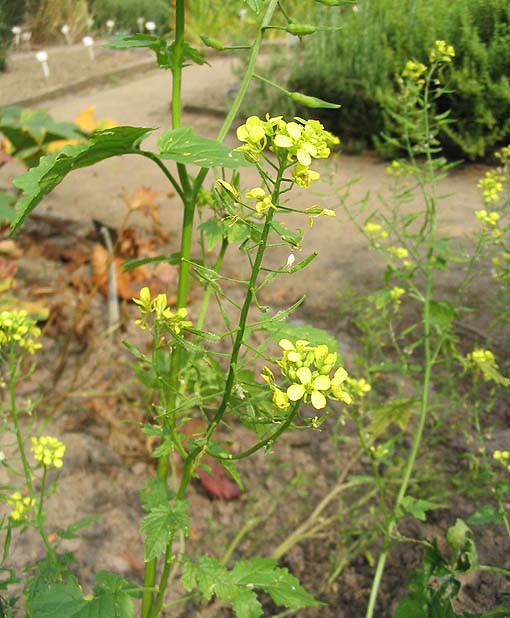
There is a saying in Greece that loosely translates as “Are you looking for the field mustard?” It means that someone is looking for something in plain sight, but can’t see what’s obviously right in front of their eyes.
Vrouves are among the most common leafy vegetables in Greece and are a collective name for many different species in the mustard genus. As the saying goes, they grow everywhere. They’re not too fussy, all they need is sun, so don’t be surprised if you see yellow little flowers growing on walls or between rocks. The flowers are yellow and pointed and bloom from April to October. In many villages it is also used in dishes and the seeds are ground down with oil to make mustard (from the Greek word σινάπι/sinapi).
Field mustard or charlock mustard is also mentioned by Theophrastus who described it as ‘healing’ and contains vitamins A, C, B, E, D, K, B6, B12, magnesium, iron, calcium and phosphorus.
🌱Purple amaranth/ βλήτα (vlitta). Amaranthus blitum
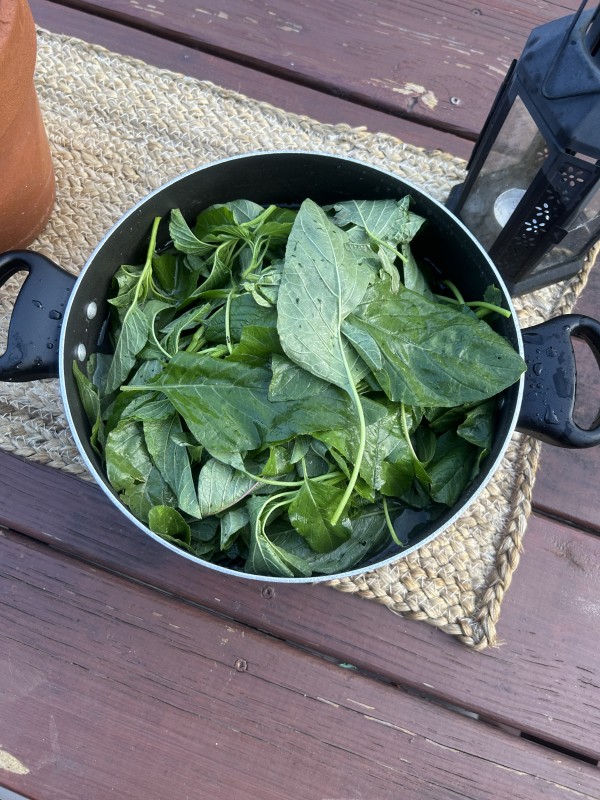

During the summer months, amaranth/vlita is often found on the Greek dinner table and is widely served in taverns. It is considered the queen of leafy greens, truly Greece’s #1 superfood. Vlita combines well with fish or seafood. There are about 75 different varieties of purple amaranth around the world.
In ancient times, its flowers were considered sacred and protected by the goddess Artemis. They were a symbol of eternal life and were often placed on graves.
Amaranth is quite easy to grow especially in the Mediterranean, and contains vitamins C, A, B, calcium, niacin, riboflavin, iron, and magnesium. Some studies suggest that it contributes to strengthening the immune system, lowering blood pressure and reducing the risk of osteoporosis.
🌱 Dandelion /ραδίκια (radikia). Taraxacum officinale
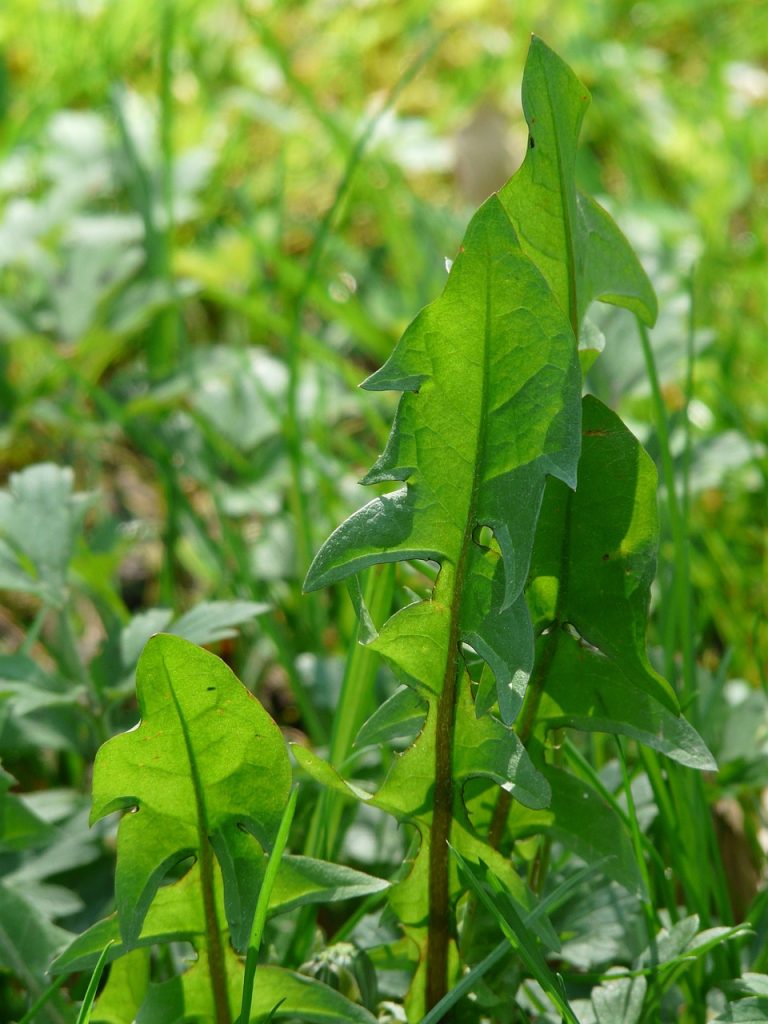
Ραδίκια/radikia is the second most common leafy vegetable served in Greek restaurants after vlita. Perhaps you could call it Greece’s number #2 superfood. Radikia is either harvested wild or cultivated on a small scale as a leafy vegetable. The leaves can be eaten either cooked or raw in various forms, such as in soup or salad.
Radikia or dandelion is probably also the most common wild leafy vegetable in many countries and it is very tasty when it is picked early and is a health bomb containing vitamins K, A, C, B, and E.
Theophrastus and others after him called the dandelion “the liver’s best friend”. It is still considered today to cleanse the blood, lower blood pressure, blood sugar and cholesterol.
Radikia can be applied in all recipes with leafy vegetables
Dandelion health products
A large variety of organic health products made from dandelion can be found here >>.
🌱 Pursley/γλιστρίδα (glistrida). Portulaca oleracea
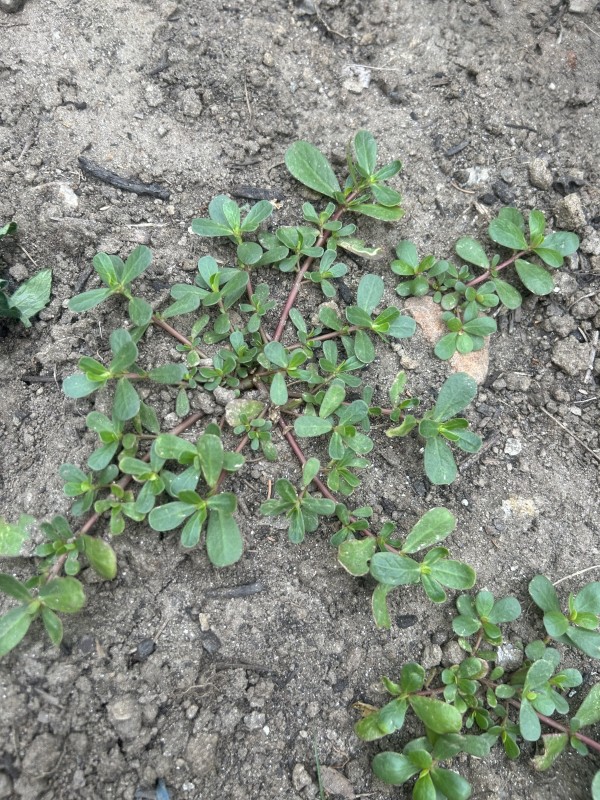
Pursley or Purslane/γλιστρίδα is a well-known salad plant that grows abundantly, mainly in vegetable gardens, without needing special care. It is used as a refreshment in salads and as a healing herb. It has been known as a medicinal plant for over 2000 years. The small leaves are dark green, crisp and thick.
Theophrastus introduced it as an early form of antibiotic to cure fever, stomachache, sore throat, headache and scurvy. Glistrida contains high levels of iron, phosphorus, magnesium and calcium.
🌱Pursley/γλιστρίδα is in many places in Greece also called andrakla/αντράκλα .
🌱Nettle/τσουκνίδα (tsouknida). Urtica dioica

Nettles probably need no introduction. Even in Greece they are eaten as salad, soup and sometimes replace spinach. The stingers are neutralized by boiling the leaves and squeezing out the water.
In the Expedition’s article on Greek herbs, nettle is listed as the country’s top one healing herb.
It is said that the ancient Greeks often started their day with a nettle drink that could strengthen the immune system, prevent colds and relieve ailments.
Nettle contains vitamins C, K, B, iron and calcium.
Nettle tea
Many different varieties of natural and organic nettle tea can be found here >>.
🌱Red mallow/ μολόχα (molocha). Malva sylvestris
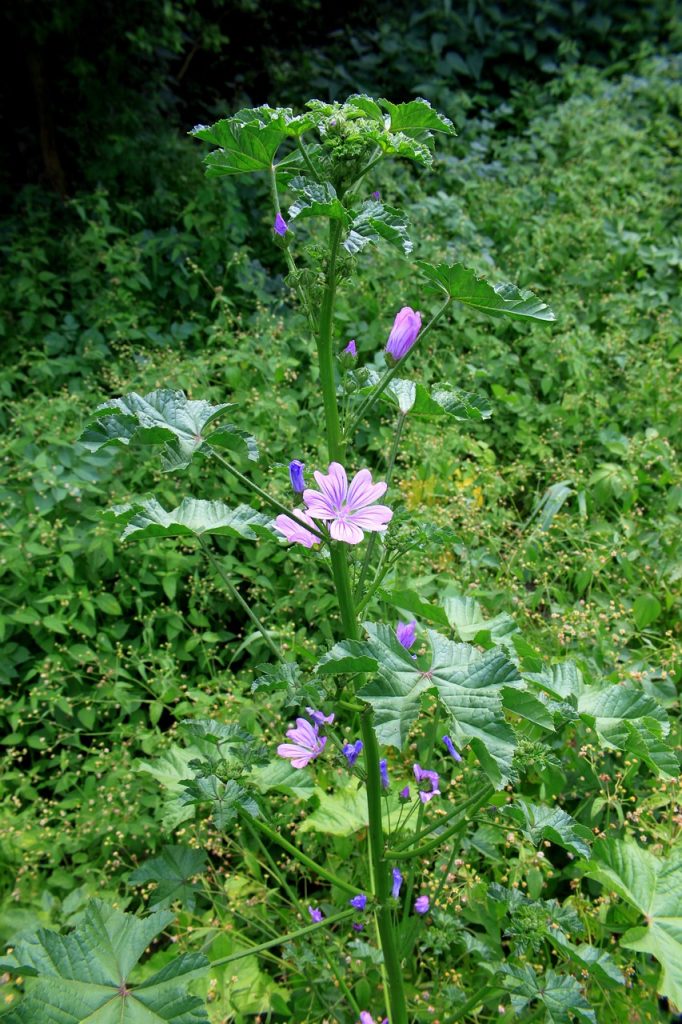
The red mallow is a very common plant across the Mediterranean region and in many other places around the world. It is very adaptable and grows not only in coastal zones but also at high altitudes. You can enjoy its color and beauty whether you are by the sea or in the mountains.
In ancient Greece, mallow was highly valued and admired by prominent philosophers such as Pythagoras and Plato. It is known that mallow was used as a prophylactic against arteriosclerosis and as an effective remedy for inflamed wounds and relief from insect bites. Its beneficial properties for health and well-being made it an important part of the ancient medical and cultural world. Maybe it is the most important variety of all time of the Greek super food.
Malva has a bitter taste. In contemporary alternative medicine, it is considered an anti-inflammatory and is prescribed for stomach problems, bronchitis, coughs and sore throats.
Greece’s super food, some lesser known leafy greens:
Sow-thistle/ ζοχιά (zochia). Sonchus oleraceus.
Very known since ancient times for its healing effects. It was used as a blood purifier and
for high fever. It is quite bitter when raw but the bitterness goes away if cooked. Sow-thistle contains vitamin C, calcium, phosphorus, magnesium and iron.
Curly dock/λάπαθο, λαπάθα (lápatho, lapátha). Rumex crispus
Lapatha belongs to the family of sliding plants and there are over 25 different species in Greece. The leaves have a sour taste, are dark green with streaks of yellow and are often used in pies or cooked with meat dishes. Lapatha is associated with many possible health benefits and is thought to relieve osteoporosis, lower blood pressure and help with insect bites. It contains vitamins C, A, B1, B2 and iron.
My garden in the USA
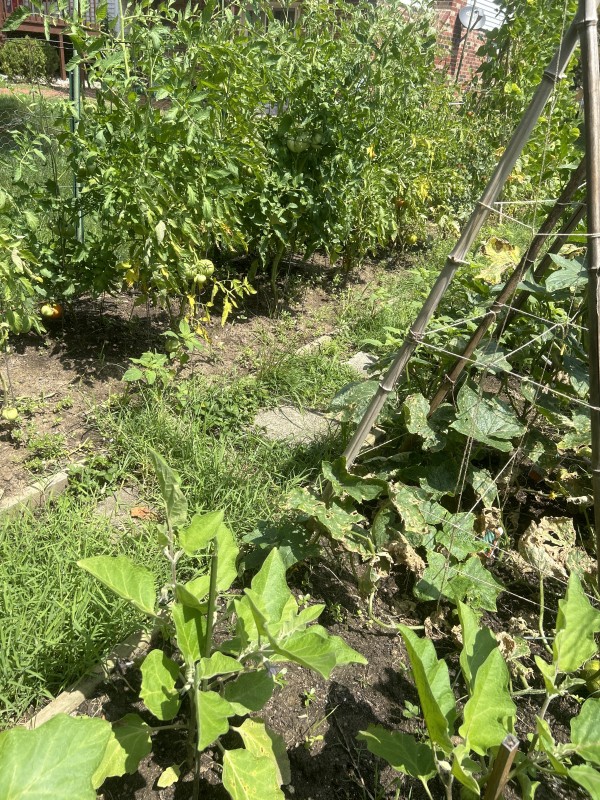
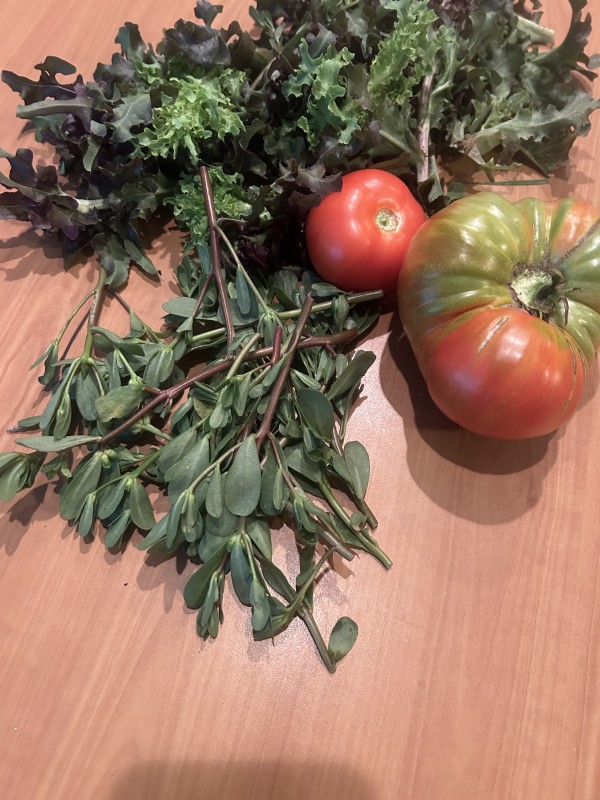
Recipe ideas for Greece’s super foods:
Vinaigrette. One part acid (vinegar, lemon, balsamic or apple cider vinegar), two parts olive oil, salt and pepper. I like to add finely chopped garlic, Dijon mustard, a little honey and herbs. If the vinaigrette is a bit thick, add a little water.
Pie dough and phyllo are often made with leafy vegetables and the variations are endless. Phyllo are now available in the freezer section of most supermarkets. Thaw it slowly in the fridge, but work quickly as they dry quickly. I cover them with damp kitchen towels. My standard recipe for pie dough is one cup of flour, one stick of butter in small cubes and one cup of water. Form it into a ball and let it rest in the fridge for half an hour. Then fix the filling by whisking together eggs and milk, salt, pepper, leafy greens and a pinch of nutmeg.
Spinach rice is a popular everyday dish in Greece and a favorite in our family. Chop and soak a large leek, finely chop fresh onion, dill and mint. Fry everything on medium heat with a little olive oil, add one cup of rice and let it sweat a little. Add the spinach and four cups of water and two vegetable broths.
Nettle drink the Socrates way is easy to make. Boil four cups of water and mix in 2 tablespoons of dried nettles. Simmer under a lid for ten minutes, mix with lemon juice and honey. Drink hot or cold.
Mustard is quite easy to make, but needs a few days before it is ready. Combine 2 oz of brown and 2 oz of yellow mustard seeds with 2 oz of beer or water and 3 oz of white wine vinegar in a jar with a lid and store in the fridge for at least 8 hours. Blend to a paste with a teaspoon of salt in a blender until you get the consistency you want. Store the mustard in a glass jar with a lid at room temperature for one to two days.
Do you have your own recipes for leafy greens or other Greek dishes? We welcome your ideas in the comments section below!
Rent a car through the expedition
Please note: booking through affiliate links in our texts means absolutely no extra cost to you. However, it is a way to support the work of the expedition, so that we can continue to offer first-class content and exciting digital adventures. More about affiliate links in our privacy policy.
Grab a taxi
Sources: Wordreference.com, itrofi.gr, eatweeds.co.uk, vita.gr, Wikipedia.org, votaniki.gr, nikosfountas.gr, medlar.gr, mixanitouxronou.gr, ennallaktikidrasi.gr, bodyinbalance.gr, peacehealth.org, nih.gov, academic.our.com, culinaryhill.com.
